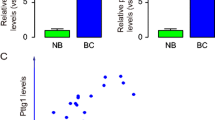Summary
To construct cukaryotic expression vector expressing full length anti-sense pituitary tumor transforming gene (PTTG) mRNA and observe its blocking effect on the potential invasion of human ovarian carcinoma cell line SK-OV-3. PCR primers containing designed enzyme cut sites were used for cloning full-length PTTG gene fragment, and the resulting PCR product was inserted into the eukaryotic vector pcDNA3. 1 in the antisense direction. The recombinant vector was then transfected into SK-OV-3 by Lipofectamine. The positive cell clone was screened by G418, PTTG and hFGF at protein level expression were detected by Western blot. The biological behavior change of transfection positive cells was observed by colony formation in soft agar assay. Our results showed that SK-OV-3 clones stably expressing full-length recombinant pcDNA3. 1-PTTGas were obtained. The expressions of PTTG and bFGF protein in transfected cells were decreased by 61.5 % and 52.3%, respectively as compared with non-transfected ones. The number of colony formation was reduced significantly in transfected cells as compared with empty vector transfected and non transfected cells. It is concluded that the recombinant vector pcDNA3. 1-PTTGas is a novel tool and provides an alternative anti-sense gene therapy targeted at PTTG in human carcinoma.
Similar content being viewed by others
References
Lin P, Shiomo M. Isolation and characterization of a pituitary tumor-transforming gene (PTTG). Mol Endo Mol Endocrinol, 1997, 4: 433
Zhang X, Horwitz G A, Prezant T Ret al. Structure, expression, and function of human pituitary tumor-transforming gene (PTTG). Mol Endocrinol, 1999, 13 (1): 156
Sitou Z, Wu J Z. Cell Cultur. Xian: World Publishing Corp. 1996. 184–186.
Dominguez A, Ramos-Morales F, Romero Fet al. hpttg, a human homologue of rat pttg, is overexpressed in hematopoietic neoplasms. Evidence for a transcriptional activation function of hPTTG. Oncogene, 1998, 17 (17): 2187
Heaney A P, Singson R, McCabe C Jet al. Expression of pituitary-tumour transforming gene in colorectal tumors. Lancet, 2000, 355(9205): 716
Saez C, Japon M A, Ramos-Morales Fet al. hpttg is over-expressed in pituitary adenomas and other primary epithelial neoplasias. Oncogene, 1999, 18(39): 5473
Zou H, McGarry T J, Bernal Tet al. Identification of a vertebrate sister-chromatid separation inhibitor involved in transformation and tumorigenesis. Science, 1999, 285 (5426): 418
Puri R, Tousson A, Chen Let al. Molecular cloning of pituitary tumor transforming gene 1 from ovarian tumors and its expression in tumors. Cancer Lett, 2001, 163(1): 131
Heaney A P, Melmed S. New pituitary oncogenes. Endocri Relat Cancer, 2002, 7: 3
Folkman J, Klagsbrun M. Angiogenic factors. Science, 2002, 23: 2442
Author information
Authors and Affiliations
Additional information
CHEN Gang, male, born in 1974. Doctor in Charge
This project was supported by a grant from the National Natural Sciences Foundation of China (No. 39840009) and the National Science Fund for Distingaished Young Scholars (No. 30025017).
Rights and permissions
About this article
Cite this article
Gang, C., Jing, L., Fujun, L. et al. Inhibitory effects of anti-sense PTTG on malignant phenotype of human ovarian carcinoma cell line SK-OV-3. Current Medical Science 24, 369–372 (2004). https://doi.org/10.1007/BF02861870
Received:
Published:
Issue Date:
DOI: https://doi.org/10.1007/BF02861870



